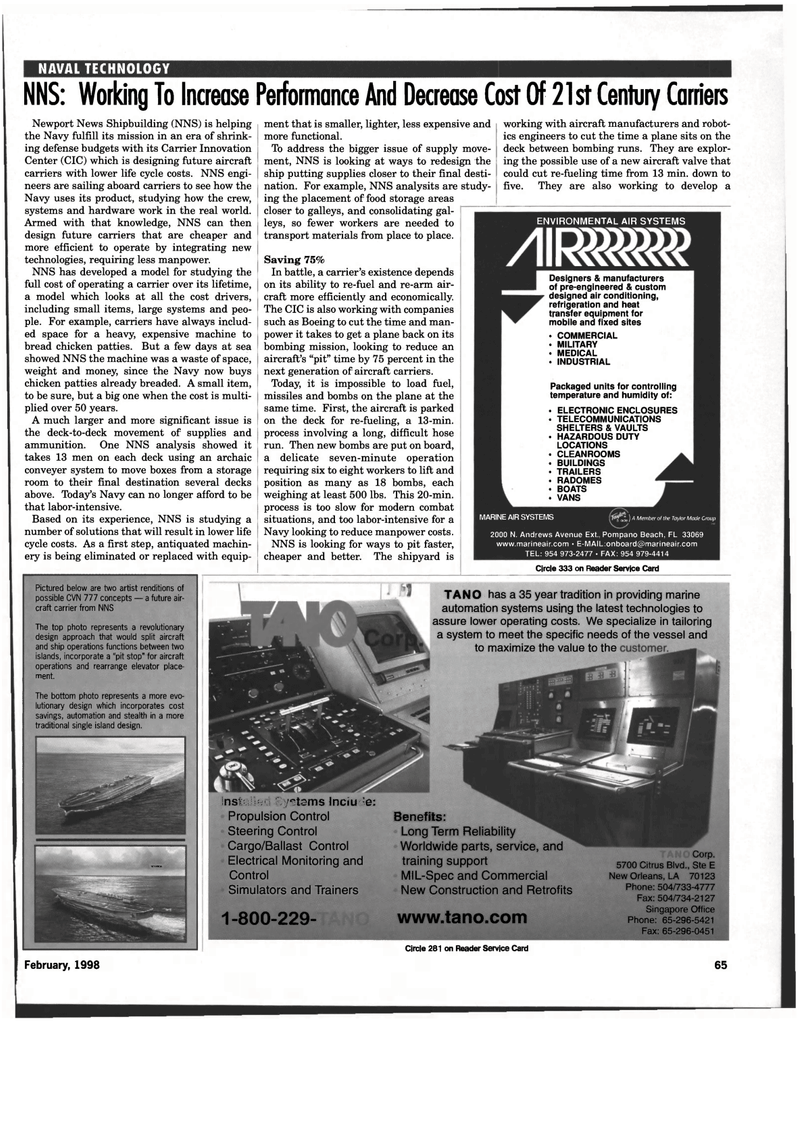
Page 69: of Maritime Reporter Magazine (February 1998)
Read this page in Pdf, Flash or Html5 edition of February 1998 Maritime Reporter Magazine
NAVAL TECHNOLOGY
NNS: Working To Increase Performance And Decrease Cost Of 21st Century Carriers
Newport News Shipbuilding (NNS) is helping the Navy fulfill its mission in an era of shrink- ing defense budgets with its Carrier Innovation
Center (CIC) which is designing future aircraft carriers with lower life cycle costs. NNS engi- neers are sailing aboard carriers to see how the
Navy uses its product, studying how the crew, systems and hardware work in the real world.
Armed with that knowledge, NNS can then design future carriers that are cheaper and more efficient to operate by integrating new technologies, requiring less manpower.
NNS has developed a model for studying the full cost of operating a carrier over its lifetime, a model which looks at all the cost drivers, including small items, large systems and peo- ple. For example, carriers have always includ- ed space for a heavy, expensive machine to bread chicken patties. But a few days at sea showed NNS the machine was a waste of space, weight and money, since the Navy now buys chicken patties already breaded. A small item, to be sure, but a big one when the cost is multi- plied over 50 years.
A much larger and more significant issue is the deck-to-deck movement of supplies and ammunition. One NNS analysis showed it takes 13 men on each deck using an archaic conveyer system to move boxes from a storage room to their final destination several decks above. Today's Navy can no longer afford to be that labor-intensive.
Based on its experience, NNS is studying a number of solutions that will result in lower life cycle costs. As a first step, antiquated machin- ery is being eliminated or replaced with equip-
Pictured below are two artist renditions of possible CVN 111 concepts — a future air- craft carrier from NNS
The top photo represents a revolutionary design approach that would split aircraft and ship operations functions between two islands, incorporate a "pit stop" for aircraft operations and rearrange elevator place- ment. ment that is smaller, lighter, less expensive and more functional.
To address the bigger issue of supply move- ment, NNS is looking at ways to redesign the ship putting supplies closer to their final desti- nation. For example, NNS analysits are study- ing the placement of food storage areas closer to galleys, and consolidating gal- leys, so fewer workers are needed to transport materials from place to place.
Saving 75%
In battle, a carrier's existence depends on its ability to re-fuel and re-arm air- craft more efficiently and economically.
The CIC is also working with companies such as Boeing to cut the time and man- power it takes to get a plane back on its bombing mission, looking to reduce an aircraft's "pit" time by 75 percent in the next generation of aircraft carriers.
Today, it is impossible to load fuel, missiles and bombs on the plane at the same time. First, the aircraft is parked on the deck for re-fueling, a 13-min. process involving a long, difficult hose run. Then new bombs are put on board, a delicate seven-minute operation requiring six to eight workers to lift and position as many as 18 bombs, each weighing at least 500 lbs. This 20-min. process is too slow for modern combat situations, and too labor-intensive for a
Navy looking to reduce manpower costs.
NNS is looking for ways to pit faster, cheaper and better. The shipyard is working with aircraft manufacturers and robot- ics engineers to cut the time a plane sits on the deck between bombing runs. They are explor- ing the possible use of a new aircraft valve that could cut re-fueling time from 13 min. down to five. They are also working to develop a
ENVIRONMENTAL AIR SYSTEMS
Designers & manufacturers of pre-engineered & custom designed air conditioning, refrigeration and heat transfer equipment for mobile and fixed sites • COMMERCIAL • MILITARY • MEDICAL • INDUSTRIAL
Packaged units for controlling temperature and humidity of: • ELECTRONIC ENCLOSURES • TELECOMMUNICATIONS
SHELTERS & VAULTS • HAZARDOUS DUTY
LOCATIONS • CLEANROOMS • BUILDINGS • TRAILERS • RADOMES • BOATS • VANS
MARINE AIR SYSTEMS ade) ^ Member of the Taylor Made Croup 2000 N. Andrews Avenue Ext., Pompano Beach, FL 33069 www.marineair.com • E-MAIL:[email protected]
TEL: 954 973-2477 • FAX: 954 979-4414
Circle 333 on Reader Service Card
The bottom photo represents a more evo- lutionary design which incorporates cost savings, automation and stealth in a more traditional single island design. • • 1-800-229-
Installed Systems Include:
Propulsion Control
Steering Control
Cargo/Ballast Control
Electrical Monitoring and
Control
Simulators and Trainers
Benefits:
Long Term Reliability
Worldwide parts, service, and training support
MIL-Spec and Commercial
New Construction and Retrofits www.tano.com
Corp. 5700 Citrus Blvd., Ste E
New Orleans, LA 70123
Phone: 504/733-4777
Fax: 504/734-2127
Singapore Office
Phone: 65-296-5421
Fax: 65-296-0451
TANO has a 35 year tradition in providing marine automation systems using the latest technologies to assure lower operating costs. We specialize in tailoring a system to meet the specific needs of the vessel and to maximize the value to the
Circle 281 on Reader Service Card
February, 1998 65

 68
68

 70
70
